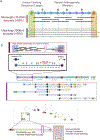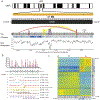Centromere studies in the era of 'telomere-to-telomere' genomics
- PMID: 32504677
- PMCID: PMC8284601
- DOI: 10.1016/j.yexcr.2020.112127
Centromere studies in the era of 'telomere-to-telomere' genomics
Abstract
We are entering into an exciting era of genomics where truly complete, high-quality assemblies of human chromosomes are available end-to-end, or from 'telomere-to-telomere' (T2T). This technological advance offers a new opportunity to include endogenous human centromeric regions in high-resolution, sequence-based studies. These emerging reference maps are expected to reveal a new functional landscape in the human genome, where centromere proteins, transcriptional regulation, and spatial organization can be examined with base-level resolution across different stages of development and disease. Such studies will depend on innovative assembly methods of extremely long tandem repeats (ETRs), or satellite DNAs, paired with the development of new, orthogonal validation methods to ensure accuracy and completeness. This review reflects the progress in centromere genomics, credited by recent advancements in long-read sequencing and assembly methods. In doing so, I will discuss the challenges that remain and the promise for a new period of scientific discovery for satellite DNA biology and centromere function.
Keywords: Centromere; Genomics; Long-read assembly; Satellite DNA; Telomere-to-telomere.
Copyright © 2020. Published by Elsevier Inc.
Figures



Similar articles
-
Dark Matter of Primate Genomes: Satellite DNA Repeats and Their Evolutionary Dynamics.Cells. 2020 Dec 18;9(12):2714. doi: 10.3390/cells9122714. Cells. 2020. PMID: 33352976 Free PMC article. Review.
-
Completing the human genome: the progress and challenge of satellite DNA assembly.Chromosome Res. 2015 Sep;23(3):421-6. doi: 10.1007/s10577-015-9488-2. Chromosome Res. 2015. PMID: 26363799 Review.
-
Centromere reference models for human chromosomes X and Y satellite arrays.Genome Res. 2014 Apr;24(4):697-707. doi: 10.1101/gr.159624.113. Epub 2014 Feb 5. Genome Res. 2014. PMID: 24501022 Free PMC article.
-
Human centromere genomics: now it's personal.Chromosome Res. 2012 Jul;20(5):621-33. doi: 10.1007/s10577-012-9295-y. Chromosome Res. 2012. PMID: 22801774 Review.
-
The structure, function and evolution of a complete human chromosome 8.Nature. 2021 May;593(7857):101-107. doi: 10.1038/s41586-021-03420-7. Epub 2021 Apr 7. Nature. 2021. PMID: 33828295 Free PMC article.
Cited by
-
Computational methods for chromosome-scale haplotype reconstruction.Genome Biol. 2021 Apr 12;22(1):101. doi: 10.1186/s13059-021-02328-9. Genome Biol. 2021. PMID: 33845884 Free PMC article. Review.
-
All these screens that we've done: how functional genetic screens have informed our understanding of ribosome biogenesis.Biosci Rep. 2023 Jul 26;43(7):BSR20230631. doi: 10.1042/BSR20230631. Biosci Rep. 2023. PMID: 37335083 Free PMC article. Review.
-
Genomic Tackling of Human Satellite DNA: Breaking Barriers through Time.Int J Mol Sci. 2021 Apr 29;22(9):4707. doi: 10.3390/ijms22094707. Int J Mol Sci. 2021. PMID: 33946766 Free PMC article. Review.
-
Novel Concept of Alpha Satellite Cascading Higher-Order Repeats (HORs) and Precise Identification of 15mer and 20mer Cascading HORs in Complete T2T-CHM13 Assembly of Human Chromosome 15.Int J Mol Sci. 2024 Apr 16;25(8):4395. doi: 10.3390/ijms25084395. Int J Mol Sci. 2024. PMID: 38673983 Free PMC article.
-
Probably Correct: Rescuing Repeats with Short and Long Reads.Genes (Basel). 2020 Dec 31;12(1):48. doi: 10.3390/genes12010048. Genes (Basel). 2020. PMID: 33396198 Free PMC article. Review.
References
-
- Yunis JJ, Yasmineh WG, Heterochromatin, satellite DNA, and cell function, Science 174 (1971) 1200–1209. - PubMed
-
- Vafa O, Sullivan KF, Chromatin containing CENP-A and α-satellite DNA is a major component of the inner kinetochore plate, Curr. Biol 7 (1997) 897–900. - PubMed
-
- Pardue ML, Gall JG, Chromosomal localization of mouse satellite DNA, Science 168 (1970) 1356–1358. - PubMed
-
- Henikoff S, Ahmad K, Malik HS, The centromere paradox: stable inheritance with rapidly evolving DNA, Science 293 (2001) 1098–1102. - PubMed
-
- Melters DP, Bradnam KR, Young HA, Telis N, May MR, Ruby JG, Sebra R, Peluso P, Eid J, Rank D, Garcia JF, DeRisi JL, Smith T, Tobias C, Ross-Ibarra J, Korf I, Chan SWL, Comparative analysis of tandem repeats from hundreds of species reveals unique insights into centromere evolution, Genome Biol. 14 (2013) R10. - PMC - PubMed

